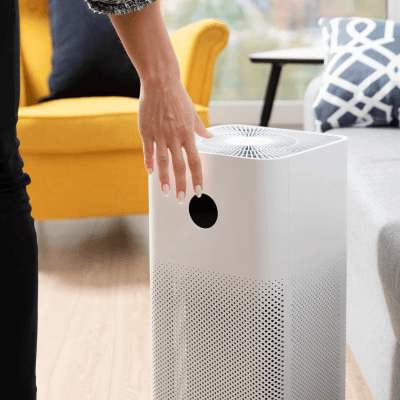Mold is a common concern for Austin homeowners, especially in our humid climate. You might have noticed mold or mildew around your home, or perhaps you’re just concerned about the health risks associated with mold spores in the air. Either way, you may be asking: Do air purifiers help with mold? The short answer: Yes, but only in certain situations. Let’s dive into the details so you can confidently address any mold issues in your home.
How Do Air Purifiers Work?

Air purifiers improve indoor air quality by filtering out airborne particles, including dust, allergens, and, yes, mold spores. Different purifiers use different technologies, but the two most effective types for mold are:
- HEPA filters: These high-efficiency filters are designed to trap particles as small as 0.3 microns. Mold spores range from 1 to 20 microns, making HEPA filters an effective option for capturing them. However, it’s important to note that the purifier only removes spores that are airborne—not those already settled on surfaces or actively growing.
Read more from the EPA about how HEPA filters work.
- UV-C light technology: Some purifiers use ultraviolet (UV-C) light to kill mold spores and other pathogens. As air passes through the purifier, the UV-C light neutralizes the spores. However, this technology is only effective on spores directly exposed to the light, meaning it won’t eliminate spores hiding in your carpets, walls, or furniture.
Air purifiers reduce airborne spores but won’t fix the underlying mold issue. If you’re seeing visible mold or experiencing persistent moisture problems, it’s time to consider a more comprehensive solution.
How Effective Are Air Purifiers for Indoor Air Quality?

Air purifiers can be highly effective in reducing airborne mold spores, particularly for improving air quality in rooms where mold spores have been disturbed (such as after cleaning or moving furniture). They are especially beneficial for people with allergies, asthma, or respiratory sensitivities, as mold spores can exacerbate these conditions.
However, air purifiers are not a cure-all. They don’t address the root cause of the mold problem—whether it’s a leaky pipe, poor ventilation, or high humidity. Purifiers work by filtering the air that passes through them, but they won’t reach spores lurking in other parts of the home, such as crawl spaces or behind drywall.
If you suspect a mold issue but can’t see visible growth, it’s a good idea to schedule a professional mold inspection. Our team at Howard Environmental can test the air and surfaces in your home to pinpoint exactly where mold is growing and how severe the issue is.
What Kills Mold Spores in the Air?

While air purifiers equipped with HEPA filters can capture mold spores, they don’t kill them. Once trapped, the spores remain on the filter, which is why it’s crucial to regularly replace or clean the filters. Over time, a dirty filter can actually become a breeding ground for mold if not maintained properly.
What kills mold spores in the air: UV-C light purifiers offer a more direct solution. These purifiers use ultraviolet light to disrupt the DNA of mold spores, effectively killing them. However, the effectiveness of UV-C purifiers can vary depending on the length of exposure and the purifier’s design. Additionally, UV-C purifiers only kill airborne spores, not those that have already settled or are growing on surfaces.
In most cases, mold removal involves both capturing and killing spores, along with addressing the conditions that allow mold to grow. Air purifiers can help with the first two steps but won’t stop mold from returning if the moisture issue persists.
Air Purifier vs. Dehumidifier: Which Is Better for Mold?
Now, you might be wondering-air purifier vs. dehumidifier. Which is the better tool for fighting mold? The answer largely depends on your situation, but in most cases, a dehumidifier is more effective at preventing mold growth.

- Dehumidifiers reduce the moisture in the air, making your home less hospitable to mold. Mold thrives in environments with humidity levels above 60%, so maintaining indoor humidity at 30-50% can significantly lower the risk of mold growth. This is especially important in Austin’s warm and humid climate, where high moisture levels can become an issue even in well-ventilated homes.
- Air purifiers help with removing existing spores from the air but won’t stop new mold growth if the conditions are right. In fact, without addressing moisture problems, you’ll likely see mold return even after the air has been “purified.”
For a comprehensive approach, consider using both an air purifier to clean the air and a dehumidifier to control moisture levels. This combination can reduce mold spores in the air while also tackling the root cause of mold growth.
Which Air Purifier Is Best for Mold?
1. HEPA Filters
HEPA filters, short for High-Efficiency Particulate Air filters, are the gold standard for trapping mold spores and other airborne particles. A True HEPA filter is designed to capture 99.97% of particles as small as 0.3 microns. Since mold spores generally range between 1 to 20 microns, a True HEPA filter is extremely effective in removing them from the air and helping give you the best indoor air quality.
- Why True HEPA? Some air purifiers may advertise “HEPA-like” or “HEPA-type” filters, but these aren’t as efficient as True HEPA filters. For mold, you’ll want to ensure that the purifier has a True HEPA label to guarantee the best results.
- Maintenance: It’s important to regularly check and replace the HEPA filter according to the manufacturer’s guidelines, as a clogged or dirty filter can reduce efficiency and allow trapped spores to be released back into the air.
2. UV-C Light Technology
UV-C light technology can neutralize mold spores and other microorganisms by disrupting their DNA, effectively killing them. When combined with a HEPA filter, UV-C light adds an extra layer of defense by sterilizing the air as it passes through the purifier.
- Effectiveness: While UV-C light is great for killing mold spores that come into direct contact with it, it’s not 100% effective on its own because spores need to spend a sufficient amount of time in the UV-C chamber for complete sterilization. This is why pairing UV-C with HEPA filtration is ideal. The HEPA filter traps the spores, and the UV-C light kills any that manage to pass through.
- Safety: Be sure to choose a model where the UV-C light is contained inside the unit and doesn’t emit light outside, as direct exposure to UV-C can be harmful to humans and pets.
3. Activated Carbon Filters
Though not directly related to mold spore removal, activated carbon filters are effective for removing musty odors often associated with mold. These filters are typically used in combination with HEPA and UV-C light to absorb gases, volatile organic compounds (VOCs), and odors that may linger due to mold growth. While activated carbon doesn’t trap mold spores, it helps improve the overall air quality and freshness of your home.
4. Coverage Area
When deciding which air purifier is best for mold in your home, consider the coverage area. Air purifiers are rated for different room sizes, and choosing one that matches the size of your space is key to ensuring it can filter the air effectively.
- Room size compatibility: If you use a purifier that’s too small for the space, it won’t be able to circulate and clean the air efficiently, leaving mold spores floating around. For larger rooms or open-concept spaces, you may need a more powerful model or multiple purifiers.
- Air changes per hour (ACH): This refers to how many times the purifier can filter the air in the room within one hour. A higher ACH rating means the purifier is more effective at removing mold spores from the air, especially in high-risk areas like basements, bathrooms, or rooms with poor ventilation.
5. CADR (Clean Air Delivery Rate)
When evaluating air purifiers, look at the Clean Air Delivery Rate (CADR), which measures how quickly the purifier can filter air of different particles, such as dust, pollen, and smoke. The higher the CADR number, the faster and more efficiently the purifier can clean the air in the room.
- Mold-specific CADR: While CADR ratings often focus on dust and pollen, these ratings can give you a general idea of the unit’s power and efficiency. When choosing an air purifier for mold, opt for a model with a high CADR rating for particulate matter.
6. Noise Level
Since air purifiers often run continuously, you’ll want to consider the noise level. Some models can be noisy at higher speeds, which may disrupt your living space, especially in bedrooms or offices. Look for purifiers that offer a balance between noise and performance, or those that come with “quiet” or “sleep” modes for nighttime use.
7. Energy Efficiency
Air purifiers can consume a significant amount of electricity if they run continuously, so checking the energy efficiency of the model is important. Look for models that are Energy Star certified, which ensures that the unit meets energy-saving standards and won’t dramatically increase your utility bills.
Recommended Air Purifiers Help With Mold

While there are many air purifiers on the market, pick which air purifier is best for mold and specifically designed for allergen control. Some reputable brands known for effective air purification in mold-prone areas include:
- Honeywell HPA300: Features True HEPA filters, suitable for large rooms, and has a high CADR rating, making it effective for removing mold spores.
- GermGuardian AC4825: A popular model that combines a True HEPA filter with UV-C light technology (what kills mold spores), ideal for small to medium-sized rooms.
- Levoit Core 300: Known for being quiet and compact, this purifier offers True HEPA filtration with an activated carbon filter for removing odors, making it a solid choice for smaller rooms.
When selecting the best air purifier for your home, consider the size and layout of your rooms and whether you need additional features like UV-C light or carbon filtration. If you’re unsure which model is right for your space, feel free to reach out to us at Howard Environmental, and we’ll recommend trusted options based on your specific needs.
Conclusion: Yes, Air Purifiers Help with Mold, but…
Air purifiers help with mold and can be an excellent tool for improving indoor air quality and reducing mold spores, but they’re not a complete solution. Arm yourself for long-term mold prevention by knowing
- what kills mold spores, such as UV-C light
- the uses of an air purifier vs dehumidifier for controlling moisture
- which air purifier is best for mold
- how to identify the source of the mold. That’s where Howard Environmental comes in.
We offer professional mold testing and inspection services across the Austin area. If you’re noticing musty odors, unexplained health issues, or visible mold, it’s time to act. Our thorough inspections help uncover hidden mold, assess the severity of the problem, and provide you with a clear plan for next steps.
Don’t wait until mold becomes a bigger problem. Contact us today for expert advice and testing, so you can take control of your indoor air quality and keep your home safe.
Ready to find out if mold is lurking in your home? Schedule a mold inspection with Howard Environmental today and breathe easier knowing your air is clean.

